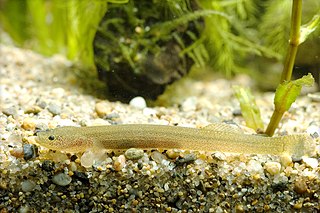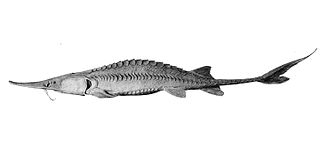
A tuna is a saltwater fish that belongs to the tribe Thunnini, a subgrouping of the Scombridae (mackerel) family. The Thunnini comprise 15 species across five genera, the sizes of which vary greatly, ranging from the bullet tuna up to the Atlantic bluefin tuna, which averages 2 m (6.6 ft) and is believed to live up to 50 years.

Manta rays are large rays belonging to the genus Mobula. The larger species, M. birostris, reaches 7 m (23 ft) in width, while the smaller, M. alfredi, reaches 5.5 m (18 ft). Both have triangular pectoral fins, horn-shaped cephalic fins and large, forward-facing mouths. They are classified among the Myliobatiformes and are placed in the family Myliobatidae. They have the largest brains and brain to body ratio of all fish, and can pass the mirror test.
Sturgeon is the common name for the 28 species of fish belonging to the family Acipenseridae. The earliest sturgeon fossils date to the Late Cretaceous, and are descended from other, earlier acipenseriform fish, which date back to the Early Jurassic period, some 174 to 201 million years ago. They are one of two living families of the Acipenseriformes alongside paddlefish (Polyodontidae). The family is grouped into four genera: Acipenser, Huso, Scaphirhynchus, and Pseudoscaphirhynchus. Two species may be extinct in the wild, and one may be entirely extinct. Sturgeons are native to subtropical, temperate and sub-Arctic rivers, lakes and coastlines of Eurasia and North America. A Maastrichtian-age fossil found in Morocco shows that they also once lived in Africa.

The conservation status of a group of organisms indicates whether the group still exists and how likely the group is to become extinct in the near future. Many factors are taken into account when assessing conservation status: not simply the number of individuals remaining, but the overall increase or decrease in the population over time, breeding success rates, and known threats. Various systems of conservation status are in use at international, multi-country, national and local levels, as well as for consumer use such as sustainable seafood advisory lists and certification. The two international systems are by the International Union for Conservation of Nature (IUCN) and The Convention on International Trade in Endangered Species of Wild Fauna and Flora (CITES).

The shovelnose sturgeon is the smallest species of freshwater sturgeon native to North America. It is often called hackleback, sand sturgeon, or switchtail. Switchtail refers to the long filament found on the upper lobe of the caudal fin. Shovelnose sturgeon are the most abundant sturgeon found in the Missouri River and Mississippi River systems, and were formerly a commercially fished sturgeon in the United States of America. In 2010, they were listed as threatened under the U.S. Endangered Species Act due to their resemblance to the endangered pallid sturgeon, with which shovelnose sturgeon are sympatric.

Thunnus is a genus of ocean-dwelling, ray-finned bony fish from the mackerel family, Scombridae. More specifically, Thunnus is one of five genera which make up the tribe Thunnini – a tribe that is collectively known as the tunas. Also called the true tunas or real tunas, Thunnus consists of eight species of tuna, divided into two subgenera.

The Pacific bluefin tuna is a predatory species of tuna found widely in the northern Pacific Ocean, but it is migratory and also recorded as a visitor to the south Pacific.

The greasy grouper, also known as the Arabian grouper or greasy rockcod, is an Indo-Pacific fish species of economic importance belonging to the family Serranidae.

The white bellbird is a species of bird in the family Cotingidae. It is the world’s loudest bird, producing vocalizations of up to 125.4 decibels. The specific epithet is often spelled alba, but albus is correct due to the masculine gender of "Procnias". It is found in forests in the Guianas, with small numbers in Venezuela and the Brazilian state of Pará, as well as Trinidad and Tobago and Panama. As in two other members of Procnias, the males have wattles, fleshy structures akin to the red skin flap that hangs from the throat of roosters.
Lethrinops albus is a species of cichlid endemic to Lake Malawi where it occurs in deep waters. This species grows to a length of 16.5 centimetres (6.5 in) TL. It can also be found in the aquarium trade.

Luciogobius is a genus of goby in the subfamily of Gobionellinae, commonly called worm gobies. It is distributed along the coast of northeastern Asia, where species can be found in Korea, China, Taiwan, and Japan. Most species occur in Japan, and several are endemic.
Luciogobius pallidus is a species of goby endemic to Japan where it is found in fresh, brackish and marine underground waters near the coasts. This species and its close relative L. albus are the only known cavefish in Japan.

The Asian swamp eel, also known as rice eel, ricefield eel, rice paddy eel or white rice-field eel, is a commercially important, air-breathing species of fish in the family Synbranchidae. It occurs in East and Southeast Asia, where it is a very common foodstuff sold throughout the region. It has been introduced to two areas near the Everglades in Florida and near Atlanta in Georgia.

Scaphirhynchus is a genus of sturgeons native to North America. All species in this genus are considered to be threatened with extinction or worse. As of 2023, the pallid sturgeon and the Alabama sturgeon are critically endangered according to the International Union for Conservation of Nature.

The Japanese raccoon dog, also known as the tanuki, is a species of canid endemic to Japan. It is one of two species in the genus Nyctereutes, alongside the common raccoon dog, of which it was traditionally thought to be a subspecies.

Chaetodon nippon, also known as the Japanese butterflyfish, is a species of butterflyfish found in the northwest Pacific Ocean in the shallow seas around Japan, South Korea, the Philippines and Taiwan.
Branchiostegus albus, is a species of marine ray-finned fish, a tilefish belonging to the family Malacanthidae. It is native to the Northwest Pacific, from southern Japan to the East China Sea. This species reaches a length of 45 cm (18 in).













